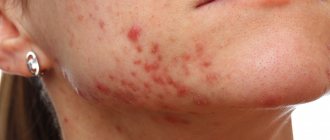Pharmacodynamics and pharmacokinetics
The principle of action is based on suppressing the process of cell wall synthesis.
Phenoxymethylpenicillin has a bactericidal effect against most gram-positive bacteria (streptococci, staphylococci), a small part of gram-negative cocci (neisseria), treponemas, corynobacteria, listeria.
The drug has no effect on Streptococcus spp., the main difference of which is the ability to independently produce penicillinase (a specific enzyme that breaks down and inactivates beta-lactam antibiotics).
Phenoxymethylpenicillin does not affect the activity of viruses, causative agents of amebiasis , most gram-negative cocci, and rickettsia.
The active component is considered acid-resistant and is destroyed upon contact with penicillinase.
Pharmacological properties
Pharmacodynamics
Phenoxymethylpenicillin is a derivative of benzylpenicillin (penicillin G). It acts bactericidal by inhibiting the synthesis of peptidoglycan in the bacterial cell wall, which leads to the destruction of the cell wall and the death of the bacterial cell itself.
The drug is active against the following bacteria:
- gram-positive microorganisms that do not produce penicillinase: Staphylococcus spp., Corynebacterium spp. (including Corynebacterium diphtheriae), Streptococcus spp. (groups A, C, G, H, L and M) (including Streptococcus pneumoniae), Listeria monocytogenes and Bacillus anthracis;
- gram-negative microorganisms (strains that do not produce penicillinase): Neisseria meningitidis, Streptobacillus moniliformis, Neisseria gonorrhoeae, Haemophilus influenzae;
- spirochetes: Leptospira spp., Treponema spp.;
- anaerobes: Clostridium spp., Actinomyces bovis.
Phenoxymethylpenicillin has no effect on the following microorganisms:
- Mycobacterium tuberculosis;
- Entamoeba histolytica;
- Rickettsiasp.;
- strains of Staphylococcus spp. producing penicillinase;
- viruses;
- most gram-negative bacteria;
- enterococci (only certain strains are sensitive to phenoxymethylpenicillin).
The drug is destroyed by the action of penicillinase (an enzyme produced by bacteria).
Pharmacokinetics
Phenoxymethylpenicillin is resistant to acids, so it is not destroyed in the acidic environment of the stomach.
Absorbed 30–60% in the alkaline environment of the small intestine; 60–80% bound to plasma proteins. The therapeutic concentration of the drug depends on the dose and is achieved 30 minutes after oral administration and persists for 3–6 hours. The maximum plasma concentration is observed 30–45 minutes after taking the tablets or suspension.
The drug penetrates the walls of the small intestine, lungs, liver, kidneys, muscles, skin, mucous membranes, most liquid media, especially in the presence of foci of inflammation; found in lower concentrations in bone tissue.
Phenoxymethylpenicillin crosses the placental barrier and is excreted in small quantities in breast milk.
Approximately 30–35% of the drug is metabolized in the liver. The half-life is 30–45 minutes. In patients with renal failure and elderly patients, the half-life is prolonged. The drug is excreted by the kidneys (25% of the dose taken unchanged and approximately 35% in the form of metabolites) and through the gastrointestinal tract (approximately 30% of the dose taken).
Indications for use
The antibacterial drug Phenoxymethylpenicillin is prescribed for infectious lesions of the oral cavity ( actinomycosis , periodontitis , bacterial stomatitis ), respiratory system ( pneumonia , bronchitis ), skin and adjacent soft tissues ( contagious impetigo , cellulitis, abscess, furunculosis, skin migrating rashes of an erythematous nature, erysipeloid) .
Instructions for use of Phenoxymethylpenicillin are recommended to prescribe the medication for botulism , tetanus, lymphadenitis (inflammatory disease of the lymphatic system), diphtheria, anthrax , syphilis, gonorrhea, leptospirosis.
The drug is prescribed to prevent relapses of bacterial endocarditis , rheumatoid arthritis, chorea minor, glomerulonephritis, rheumatism , as well as to prevent infectious complications after surgical interventions.
Special instructions for the use of the drug Phenoxymethylpenicillin
With hypersensitivity to cephalosporin antibiotics, there may be a cross-allergy to penicillins (5–10% of cases). Phenoxymethylpenicillin should be prescribed with caution to patients with allergic diathesis and asthma. If allergic reactions occur, stop taking phenoxymethylpenicillin and, depending on the severity of the reaction, prescribe epinephrine, corticosteroids and antihistamines. For patients taking drugs of the penicillin group for the prevention of rheumatic diseases, it is advisable to switch to prophylactic use of any other antibacterial agents a week before surgical interventions (tonsillectomy, tooth extraction, etc.); after surgery, in order to prevent possible bacteremia, their use should be resumed. With long-term use of phenoxymethylpenicillin, it is recommended to periodically examine the cellular composition of peripheral blood and evaluate the functional state of the kidneys.
Side effects
The antibiotic can cause allergic responses in the form of rhinitis, hyperemia (local redness) of the skin, angioedema, conjunctivitis, and urticaria.
anaphylactic shock , eosinophilia, serum sickness, fever and arthralgia develop during treatment
Phenoxymethylpenicillin tablets can provoke the development of leukopenia, pancytopenia, hemolytic anemia , thrombocytopenia and agranulocytosis.
Digestive tract: vesicular cheilitis (caused by the irritating effect of the active component on the mucous walls), stomatitis, glossitis , dyspeptic disorders (diarrhea syndrome, vomiting, epigastric discomfort and nausea), dry mouth, perversion of taste perception, loss of appetite, pseudomembranous enterocolitis ( rarely occurs).
During treatment, the development of pharyngitis, vasculitis, and interstitial neuritis .
Phenoxymethylpenicillin
Inside, 30-60 minutes before meals, with plenty of liquid.
Adults and children over 12 years old
Upper respiratory tract infections, including scarlet fever and erysipelas, caused by Streptococcus spp. groups A, C, G, H, L and M
: 125-250 mg every 6-8 hours.
Respiratory tract infections, including otitis media, caused by Streptococcus pneumonia
: 250-500 mg every 6 hours until normal body temperature is restored and for at least 2 more days.
Skin and soft tissue infections caused by Staphylococcus spp
.: 250-500 mg every 6-8 hours.
Infections of the oral cavity and pharynx (gingivitis, Vincent's pharyngitis, bacterial stomatitis, periodontitis, actinomycosis)
: 250-500 mg every 6-8 hours.
Children from 3 to 6 years old
prescribed in a daily dose: 15-30 mg/kg (3-6 tablets of 100 mg or 1-2 tablets of 250 mg), on average 100-125 mg (1 tablet of 100 mg or U2 tablets of 250 mg) 3 times a day day;
from 6 to 12 years
prescribed in a daily dose: 10-20 mg/kg (3-8 tablets of 100 mg or 1-3 tablets of 250 mg) on average 200-250 mg (2 tablets of 100 mg or 1 tablet of 250 mg) 3 times a day .
Duration of treatment
: usually 5-7 days; for infections caused by Streptococcus pneumoniae - at least 10 days.
Children under 3 years of age
It is preferable to administer Phenoxymethylpenicillin in the form of a suspension (the drug is available in the form of a powder for preparing a suspension). The maximum daily dose for children is 50 mg/kg. The maximum single and daily dose for children should not exceed the maximum single and daily dose for an adult.
To prevent recurrence of rheumatic fever and/or minor chorea
- 125-500 mg 2 times a day for a long time.
In patients receiving the drug to prevent rheumatic fever, the dose should be doubled before undergoing planned surgical interventions (tonsillectomy, tooth extraction) and during postoperative prophylaxis.
For the prevention of bacterial endocarditis after minor surgical interventions
(including dental) adults and older children (body weight more than 30 kg) with heart defects - prescribe 2 g 1 hour before the intervention and 500 mg every 6 hours after it for 2 days. Children weighing less than 30 kg: 1 g 1 hour before the intervention and 500 mg 6 hours after it.
For severe chronic renal failure and anuria
the interval between doses is increased to 12 hours.
For patients with liver failure
the required dose of the drug should not be reduced due to the low toxicity of phenoxymethylpenicillin.
Phenoxymethylpenicillin, instructions for use (Method and dosage)
The tablets are taken one hour before meals with a sufficient amount of liquid.
Antibiotic dosage regimen for adults and children over twelve years of age: 3-4 times a day, 500-1000 mg (1 mg contains 1610 units).
Patients with severe damage to the renal system are recommended to take the medication at intervals of at least 12 hours.
The duration of therapy with Phenoxymethylpenicillin is on average 5-7 days.
When treating infectious diseases caused by beta-hemolytic streptococcus, the course of antibacterial therapy is recommended to be continued for three days after stabilization of body temperature (on average 7-14 days).
Prevention of attacks of minor chorea and rheumatic attacks is achieved by taking 500 mg of the drug twice a day. Before surgery, 2000 mg of antibiotic is prescribed to prevent infectious complications, then 500 mg every 6 hours for two days.
Suspensions are intended for use in pediatric practice. Take at the rate of 20–50 mg per kg of weight.
Release form and composition
Phenoxymethylpenicillin is available in the following forms:
- tablets: flat-cylindrical, round, white or almost white, with a bevel (dosage 100 mg) or with a bevel and a score (dosage 250 mg) (10 pcs. in blister or blister-free packages; in a cardboard pack of 1, 2 or 3 contour packaging);
- powder for the preparation of a suspension for oral administration: white or almost white, with a specific odor (2.5 g in bags, 30 bags in a cardboard box, complete with or without a plastic cup; 5 g in bags, 15 bags in a cardboard box complete with or without a plastic cup).
Composition per 1 tablet:
- active ingredient: phenoxymethylpenicillin – 100 mg or 250 mg;
- auxiliary components: talc, lactose monohydrate, calcium stearate, potato starch.
Composition for 1 sachet of powder for preparing the suspension:
- active ingredient: phenoxymethylpenicillin – 37.5 mg or 75 mg;
- auxiliary components: sodium benzoate, sucrose, citric acid monohydrate, raspberry flavor.
Interaction
Phenoxymethylpenicillin reduces the effectiveness of oral contraceptives, as well as medications whose metabolism produces para-aminobenzoic acid . The opposite effect is observed with simultaneous therapy with indirect anticoagulants .
Treatment with ethinyl estradiol significantly increases the risk of breakthrough bleeding . When taking allopurinol, the risk of an allergic response in the form of skin rashes increases.
Phenylbutazone, diuretic medications, non-steroidal anti-inflammatory drugs increase the level of antibiotic in the blood by reducing secretion in the renal tubules.
Food, laxatives, antacids, aminoglycosides, glucosamine reduce the quality and rate of adsorption. The opposite effect is recorded when taking ascorbic acid.
Synergistic action is observed with simultaneous administration of Phenoxymethylpenicillin and bactericidal antibiotics (a number of cephalosporins, vancomycin, rifampicin, cycloserine ).
Antagonism of action is observed during treatment with bacteriostatic antibiotics (lincosamides, macrolides, tetracyclines, chloramphenicol ).
Drug interactions
With the simultaneous use of Phenoxymethylpenicillin with indirect anticoagulants, their effectiveness increases; with oral contraceptives and drugs that are metabolized to form para-aminobenzoic acid - their effectiveness decreases; with ascorbic acid – absorption of phenoxymethylpenicillin increases; with glucosamine, laxatives, antacids, aminoglycosides and food - the absorption of phenoxymethylpenicillin is reduced.
Bacteriostatic antibiotics (including chloramphenicol, tetracyclines, macrolides, lincosamides) exhibit antagonism; aminoglycosides and bactericidal antibiotics (including cycloserine, rifampicin, cephalosporins, vancomycin): exhibit synergism - their combined use with phenoxymethylpenicillin has a stronger effect than the total effect when used separately.
Concomitant use with allopurinol increases the likelihood of developing allergies (skin rash).
The effect of the drug is enhanced when taken together with phenylbutazone, diuretics, non-steroidal anti-inflammatory drugs, allopurinol and other substances that reduce tubular secretion.
Concomitant use with ethinyl estradiol increases the risk of breakthrough bleeding.
special instructions
If, in the first days of therapy or throughout the course of antibiotic use, persistent, severe diarrhea with dehydration is observed, the treating doctor needs to conduct additional diagnostics to exclude the diagnosis of “pseudomembranous colitis”.
Long-term use of the medication, as well as its re-prescription in a short time, can lead to the development of superinfection .
Phenoxymethylpenicillin analogues
Level 4 ATC code matches:
Benzylpenicillin sodium salt
Bicillin
Extensillin
Retarpen
Benzylpenicillin
Sulacillin
Analogues of the drug: Ospen , Kliatsil , Vepicombin , Megacillin Oral (matching active component).

